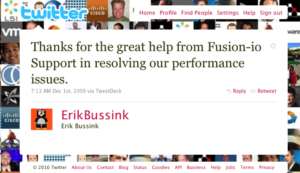
To help gain insight into the results of our soon to be published Social Media Fitness Study, I interviewed a number of marketing professionals including Trip Hunter, VP Brand Marketing of FUSION-IO, a recently public company that is doing really well on all fronts. Trip, as many of you know, worked at Renegade for many years, so of course, I’m completely bias about his talents. Nonetheless, I think you will find what he has to say quite informative and insightful.
DN: B2C companies outscored B2B companies in the Social Media Fitness study. Do you have any thoughts on why this might be the case?
B2C companies are much better at engaging with people as individuals. B2B companies market like the end consumer isn’t a human being. They are a collection of survey responses and data points. They’re not. They are real- live human beings too that get sad, and find things funny, and care about their overeating.
I also think there is a belief that the level of passion that consumers in B2C have for brands is a lot higher and more a part of ‘who they are’ than exists in B2B brands. People strongly identify with the brands in their life. They help define who they are. “I’m an apple person”, or “I drive a BMW.” You don’t hear so much someone say “I’m an HP 980 server guy”. So I think B2C brands are better positioned to capitalize on this. It is not always true, but it’s a perception among B2B that individuals don’t identify with B2B brands as much, so why bother?
DN: Do you think there is still skepticism among B2B marketers that social can help them achieve their business goals?
I do think there is skepticism here, especially among more established and mature industries, because it is difficult to find a point of view or create content that is newsworthy, or interesting, or engaging. If you can’t get people involved in your story, then you might walk away. Fusion is lucky in that it is a technology that is very innovative, and new, and because of that, techies really pay attention to our story. They are constantly talking about Fusion, and playing with our solutions, and benchmarking them against the existing status quo, and engaging with us. Their passion for Fusion is genuine, and we would be the fool not to engage and share and facilitate in the growth of that passion. A lot of people are asking a lot of questions, because what we do is so revolutionary. If we don’t answer, someone else less qualified will. By facilitating understanding, we ultimately help them find solutions for the current issues that plague traditional data storage architecture.
DN: What is social media doing for your business?
We consistently generate qualified leads through SM. When prospects ask the general community a question about Fusion, we put them directly in touch with someone at Fusion who can answer that question. More often than not, this leads to further conversations which lead to sales. As our director of social media said “I am the SM switchboard operator who connects people to the right person in the right department. I communicate with customers and potential customers directly and help them out. Our efforts are as much about customer service, if not more, than about lead generation.”
DN: Less than 1/3 of the companies surveyed had a disaster plan in place. What triggered the development of a disaster plan at FusionIO and did it work when you had to use it?
There are at least two kinds of disasters: Disasters that shake the house, and those that knock it down. Our disaster plan covers the former well. We’re working on the latter.
Disasters that shake the house happen almost everyday. Someone makes a negative or incorrect comment about us, or incorrectly compares us to a competitor. Our first negative comment through SM was back in 2009, and we have been creating our disaster plan ever since. As a result of that negative comment, we contacted the customer, helped him out, and turned him into an evangelist. He went on to make supportive and positive comments about us from then on. (see below) Recently we’ve been adding “what if” scenarios to the playbook. Being a public company, we have to be prepared.
In general, we’ve learned that the quicker we are able to respond, the more favorably things go. There’s no way to fully measure the impact of our direct communications with followers, whether they be customers, fans, or critics, but we believe it’s invaluable. Because we have been very approachable and communicative, people expect honest and quick answers from us. They know they can reach out to us via social networks and we will respond and help them.

One key component of our plan is to be measured in our response. Sometimes people just want attention-want to be recognized, and you have to know when to walk away. What we have learned is that there is a code of conduct in the community, and many times it is self regulating. Recently a guy made a video about us that wasn’t based in fact. We responded saying we would love to discuss his POV offline as is would be a rather in-depth discussion. He had no interest in doing this-he was looking for attention. But the community dealt with him, discounting his claims and eventually stopped listening. This was a huge homerun for us-So much more credible than if we are telling him he is wrong.
DN: Most companies especially B2B struggle to develop engaging content and get their customers to pitch in. How have you been able to accomplish this?
We are always trying to grow engagement with our customers, and we are not as far along as we would like to be. That said, we are so new that a broad understanding of our technology doesn’t exist yet. People want to know more, so getting them involved is not as hard as it might be for others.
We treat them like the intelligent, opinionated, passionate human beings they are. B to B companies’ customers are still consumers and human beings. We may not have the massive number of followers that consumer brands do, but our fans are just as loyal and passionate.
DN: You mentioned that you are in the process of auditing all of your social channels — what do hope to learn from this audit?
We are hoping to learn a lot of things, especially where we stand relative to our competitors. Since we sent you that answer, we have gathered some revealing numbers. Even though we’re much tinier than our largest competitor, we are gaining followers as a percentage of overall audience faster than they are, and in the area of measurement that really matters–shares–we are also ahead. People click on our links and share our content on Twitter more than they do with our largest competitor, so that is promising.
We also want to find out what we need to do better. B2C companies are known for creating very engaging content on channels such as FB and Twitter-we can learn a lot from them and how some types of B2C efforts can translate across to B2B.
 One of the findings that surprised me in the Social Media Fitness Study was that large companies seem to be far more “socially fit” than small companies. I suspect the reason for my surprise is that I have worked with a handful of well-funded fast growing start-ups that totally get social and who squeeze every last drop of value out of it. One such company is TagMan, the global leader in tag management, whose Marketing Director, Nelleke Kloet offered up her input on the results of the study. Since TagMan is in the business of helping clients figure out how to optimize their digital media activities and they have data that shows the disproportionate power of social media to drive traffic and leads, it should come as no surprise that Nelleke is both a believer and a “fit” practitioner.
One of the findings that surprised me in the Social Media Fitness Study was that large companies seem to be far more “socially fit” than small companies. I suspect the reason for my surprise is that I have worked with a handful of well-funded fast growing start-ups that totally get social and who squeeze every last drop of value out of it. One such company is TagMan, the global leader in tag management, whose Marketing Director, Nelleke Kloet offered up her input on the results of the study. Since TagMan is in the business of helping clients figure out how to optimize their digital media activities and they have data that shows the disproportionate power of social media to drive traffic and leads, it should come as no surprise that Nelleke is both a believer and a “fit” practitioner.
